It’s Holiday Campaign Time… Already
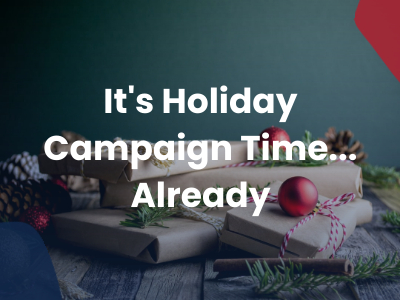
55% of consumers say that they will start their holiday shopping before Halloween this year. This means, the holiday season is here early! Consumers are worried about increased shipping times and product outages, pushing them to get their shopping done early. Americans are also expected to spend 7%-9% more this holiday season! What do you need to get your Holiday campaign set up on time?
Supply Chain and Shipping Issues
Pandemic-related shipping delays have gotten a lot better this year, but many companies are expecting large delays, due to volume, this holiday season. Also, many shipping companies’ deadline for Christmas deliveries is earlier this year. For example, FedEx’s Economy deadline is December 9th, UPS is December 16th, and USPS is the 15th. USPS also updated Holiday pricing this week on October 3rd.
Just about every part of the supply chain has been disrupted. There’s a shortages of factory workers, shortages of cargo ships and containers, large scale storms, a lack of truck drivers and warehouse employees, and retail workers. Big companies like Nike, H&M, and Ikea have already been affected.
What does this mean for you?
The best time to get started on your holiday campaign is RIGHT NOW. Especially if you are a small business; take advantage of all those big companies’ supply chain issues!
Good campaigns take time to set up and the sooner you can get your message out, the better. In the past the rule of thumb has been to have your campaign live by November 19th; however, a lot of brands have already started easing into their holiday campaigns. (Looking at you, Pottery Barn.)
What do you need to set up your holiday campaign?
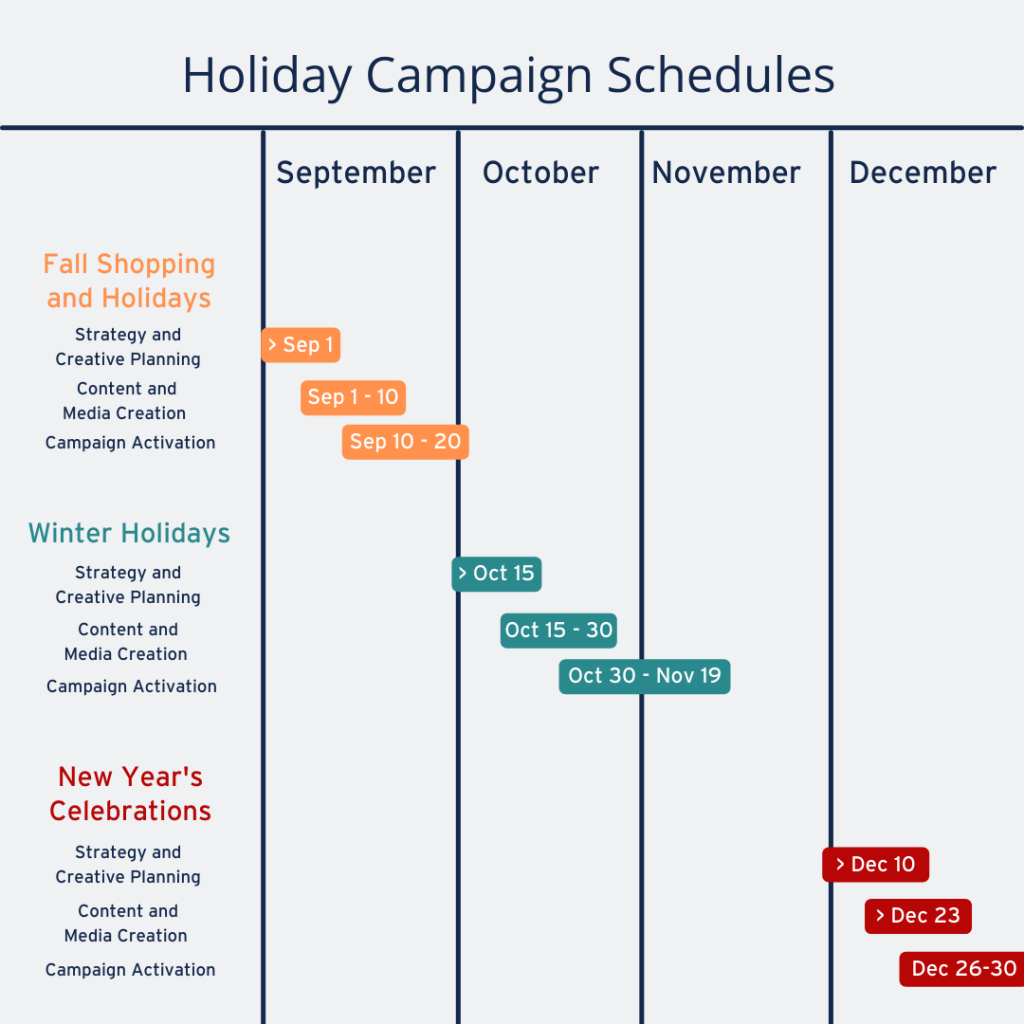
Step 1. Have a plan! That’s why it’s a campaign and not just content! A strategy is key! How do you know what should be holiday 2021 strategy? Start by asking the “why.” Why are you doing a holiday campaign in the first place? Do you have an awesome product that a lot of people would love? The next step is the campaign objectives. What do you want to specifically do you want to accomplish with this campaign? Are you trying to build brand awareness, drive traffic, or sell a specific product? Once you know what you want to accomplish, the next step is to figure out what channels and methods would be the most effective way to reach your audience.
All of these things are your strategy: the why, the what, and the how.
The next step to planning a campaign is content and message. You know what your goal is, now you make the creative that goes with it. Whether that be social content, print and mail, or digital ads, or hopefully, some combination of all the channels!
After putting your campaign out into the world, the next step is to learn. This is the data gathering and retargeting phase. A one step campaign isn’t going to be as effective as a campaign that customers on a journey.
Marketing Channel highlight: TikTok
TikTok is going to be a powerful channel this holiday season. 47% of surveyed TikTok users said that TikTok is likely to inspire a gift this year. 39% said that they discovered a product or brand on TikTok, and 77% said that they have bought things because of TikTok. TikTok is also offering incentives for advertisers to use their platform.
Do you have your holiday campaign ready to go?
What is the value of companies promoting Flow State?

With many companies adjusting to being back in the office or a hybrid work model, employees are having to change their Flow State. What is a Flow State? (Sometimes just called Flow.) Flow is simply that state of mind in which we feel and perform our best and feel at ease. We all have systems or processes that make it naturally easier for us to access Flow. We can, however, also we can take steps that can allow us to access it.
Switching up work environments over the past year and a half has facilitated many employees having to adjust how the access their Flow State. What is the value of companies promoting Flow State? How has the changing work model impacted Flow? And how can you access your Flow State and increase productivity?
What is Flow?
Your Flow State is what is happening mentally when you are “in the zone.” It’s being fully engaged in a task. Flow was first identified and popularized by psychology researcher, Mihaly Csikszentmihalyi, from Claremont Graduate University in California. Everyone’s Flow State is different is directly connected to their effort and creativity. When you are in your Flow State, you brain is locked into process and knows exactly what it is going to do from one moment to the next.
What is the value of companies promoting Flow State?
Flow State sounds abstract and kind of like a fuzzy motivation tool. How can it actually benefit companies? The main way is that when employees are in their Flow State, they are doing their best work. Not only that, employees who work in a Flow State often gain greater satisfaction from their work and a that contributes to motivation and company loyalty. While working in a Flow State, employees have more concentrate and focus and therefore, less distractions. The clarity that comes form that leads to innovation. All of these things are qualities that make up exceptional employees.
Flow State can be broken by distraction. Employee distraction is also detrimental to companies. Microsoft’s 2020 WFH study found that before the pandemic, on average, workers felt like 52% of their day was wasted by distractions and unnecessary disturbances. A 2013 study found that employees who were frequently interrupted and dealt with a lot a distractions reported higher fatigue and burnout rates. Burnt out employees are more likely to make mistakes, call in sick, as well as look for new jobs. (As we’ve seen this year with The Great Resignation.)
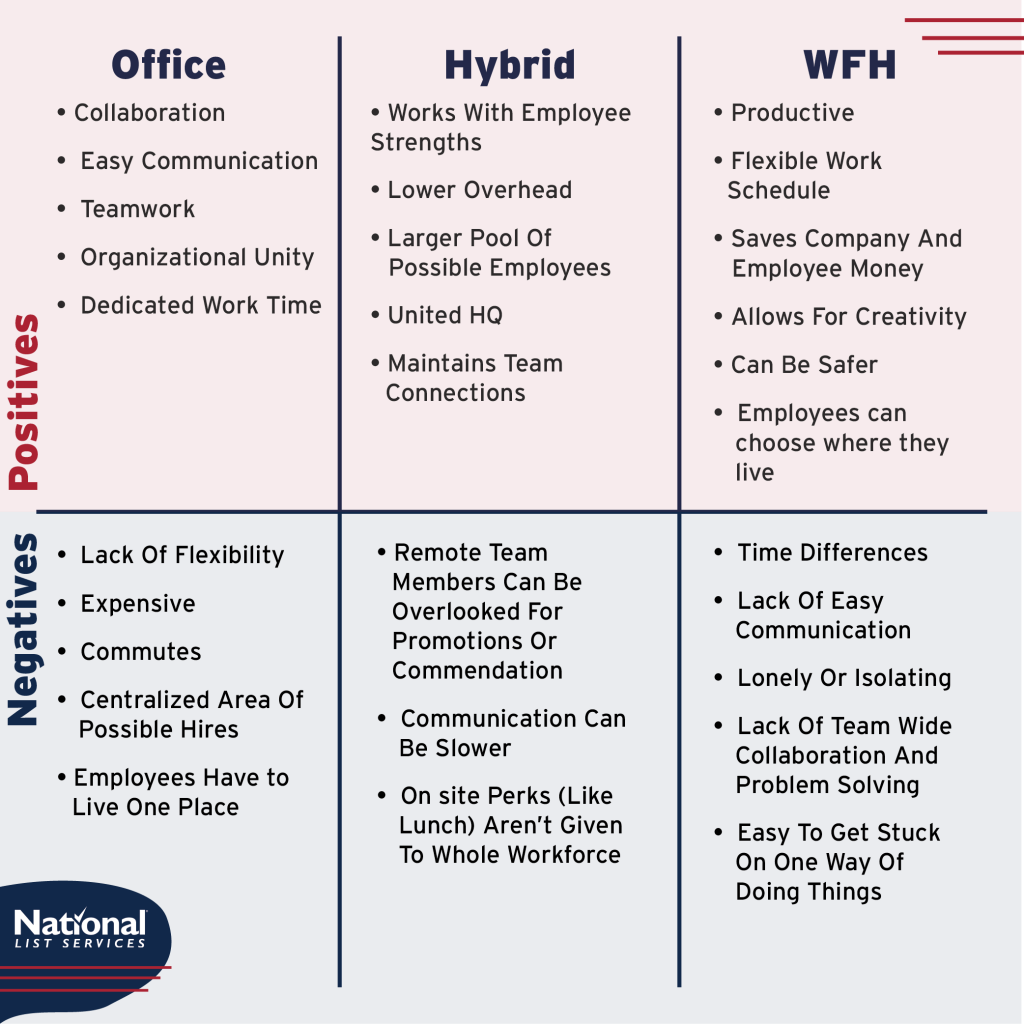
How has the changing work model impacted Flow?
One of the main advantages to a hybrid work model or allowing employees to choose weather or not they WFH, is that help each employee work in an environment that best suits them. Some employees can tap into their Flow State best in a quiet, comfortable space; weather that be at home or in the office, free of home’s distractions such as children or pets. Others like the background noise of a coffee shop. Some enjoy the collaboration of working in the office and having coworkers around them.
This year has given a lot of people an opportunity to find which type of work environment actually works best for them. Of the over 1,200 employees and 133 executives surveyed in Microsoft’s WFH study at the end of last year, 55% said they would prefer to still work remotely at least 3 days a week. And before this past year, many of those people probably wouldn’t have been given the chance to know what work environment worked best for them.
And how can you access your Flow State and increase productivity?
Here are the 2 main steps needed to tap into your flow state.
- First, you must observe yourself. For the next two weeks, observe yourself, notice what you’re doing, and look for the clues of flow: losing your sense of time or self, feeling that you’re acting with ease, gaining new insights, and having a positive feedback loop.
- Then, when you are in a state of flow, broaden your awareness: Notice and remember the activities surrounding you. Recognize what you’re physically doing and think about what you’re doing mentally.
What ways have you found to be effective in “getting in the zone” and accessing your Flow State?
The Value of the Social Proof Phenomenon

The Social Proof Phenomenon is a foundation piece of how our culture buys now. Between Instagram Influencers, Yelp reviews, and 5 star Amazon products, most of us make purchase decisions on the value others see in the product. How can Social Proof and online reviews work for you?
The Social Proof Phenomenon
What do online reviews have to do with “Social Proof?” “Social Proof” is the phenomenon based on the fact that it’s easier to buy things or trust companies if we know that other people already have. Our peers provide the proof of something’s value. None of us would buy something on Amazon with 10,000 1 star reviews. We trust those 10,000 strangers because that product connects us as a community.
“Social proof” is also part of the transparency that builds brand trust. Most consumers (almost 88%) research a business before buying from them. A lot of that research comes from reviews and reading what other people have said about their experiences.
What Can Social Proof Do For You?
Reviews can help educate consumers on your products and services. Reviewers usually talk about their specific experiences in their reviews. It can be an easier way for potential customers to learn more about what you offer.
Reviews Boost SEO. Specifically, Google Reviews. Google indexes reviews connected to your listing to help filter results. Especially for local traffic. “Best __ Near Me” is decided by reviews and stars. Customers will often use your keywords in reviews without even realizing it. This helps Google learn about you.
What Can You Do To Collect Reviews?
People are inclined to leave reviews if they a specifically positive or negative experience. Therefore, work hard to provide an overwhelmingly positive expertise for your customers! (You should be doing this anyway; the review is just a byproduct. 😉 )
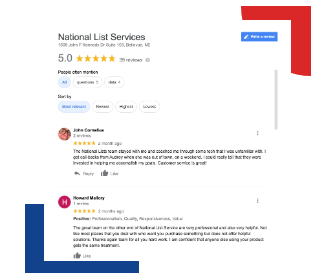
People like to do things for other people so a great way to collect reviews is to just ask for them! A follow up survey email after they buy from you is an easy way to this. Ask them specific, easy to answer questions about things such as: service response times, shipping times, product or service quality etc.
Make it easy to review you. No one has time to take 10 minuets following a complicated review survey with long required written answers. People are doing you a favor by reviewing you, show that you appreciate it by being respectful of their time and effort. Take out pain points of the review process: go through and make sure there aren’t any unnecessary steps or questions. Double check the user interface, id it easy to figure out?
Incentivizing your reviews (specifically ecommerce) is a big no-no! As temping as it is to show your appreciation for the review with a coupon or free shipping, or something: don’t. Both Google and Yelp have policies in place banning incentivized reviews. They will take the reviews down and give you a slap on the wrist.
What To Do With Reviews Once You Have Them
You have the reviews – now what? Here’s 2 ways to leverage them!
- Show them off
Let your reviews sell your product for you. Happy previous customers can be a great way to convince your potentials to buy from you! Show off your reviews on your home page with Google review widget or prominently feature some reviews as part of the design. Don’t forget to ask for permission first if you are going to highlight a specific review, especially if you are going to use their picture. - Engage with reviewers
let them know you appreciate them! It doesn’t have to be a big deal, simply liking the review or just saying thanks goes a long way. That little bit of effort can turn a happy customer into a loyal one. And a lot of marketing automation software makes replying to reviews across multiple platforms easy.
Do you have a favorite customer review?
While we are on the subject… leave us a review! 😜
What Can Your Team Do Stay Productive?
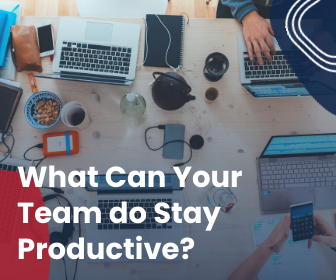
When working as part of a team, how we work alone as well as how we work together contributes to productivity and efficiency. When employees are stressed or exhausted, engagement and productivity dip and the whole company can feel the effects. It can be hard to stay productive.
Managing stress has been a challenge for a lot of people this year. In Asana’s Anatomy of Work 2021 study, 71% of workers said that they felt burnt out at least once in the last year. Also, 42% rated their stress levels as high or very high. 😳
So, what can you as an individual and you as a team do to maintain your efficiency and productivity?
What Can You Do as A Team to Stay Productive?
Unfortunately, work related stress often has to do with environment. When one person is feeling burnt out on your team, it can bring the whole team down. What can you do to create a less stress inducing work environment?
Talk It Out
Ewww, right? However, it’s impossible to know what is wrong or how you can help a situation if you don’t know at the problem is. Take in interest in people you work with. Is there anything going on in their life that might be adding stress? Is a process or workflow just not working for and its making things difficult?
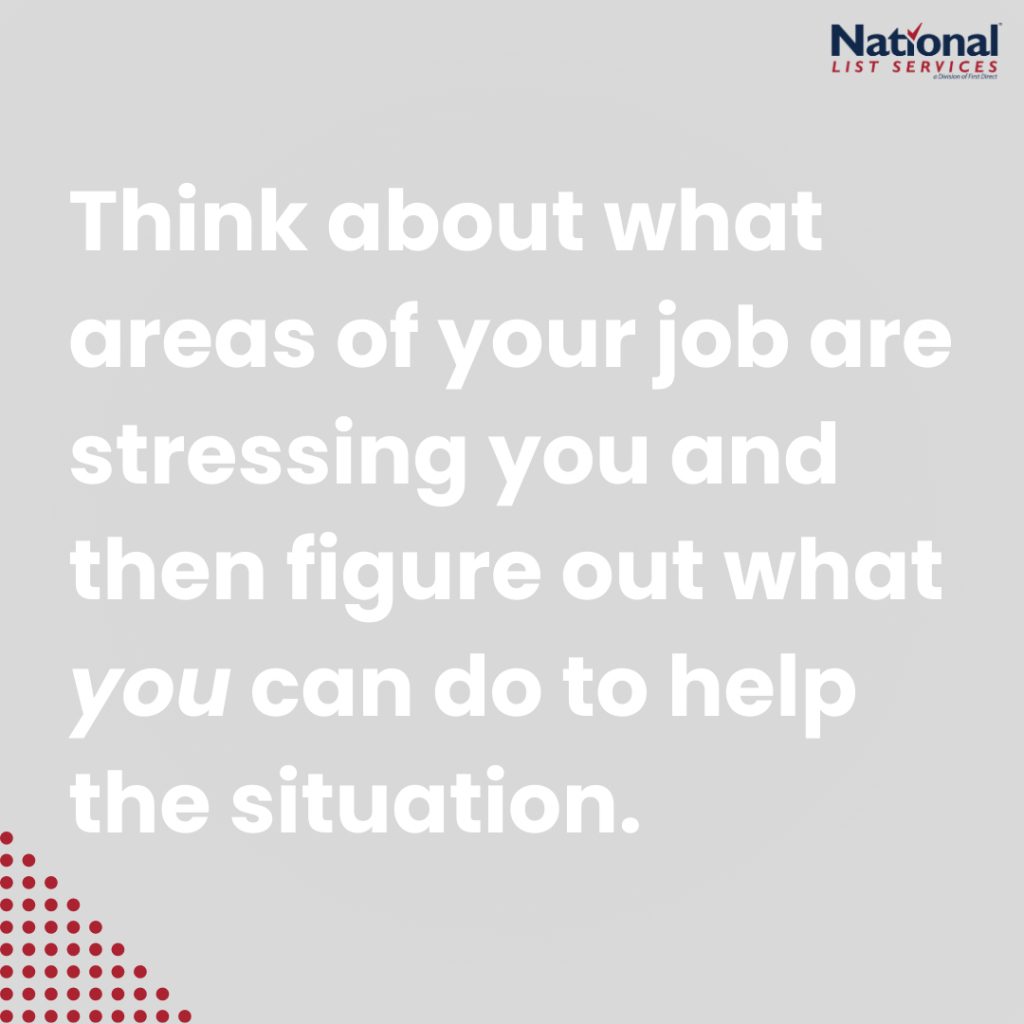
Once you understand how your team is feeling, don’t disregard it! See what you can do to make things run smoother.
Take Control Over Your Situation
We are all responsible for ourselves. If you are lucky enough to have anatomy in your job, use it! Think about what areas of your job are stressing you and then figure out what you can do to help the situation. For example, do you struggle with being productive in the afternoons because you hit a massive exhaustion wall? Could you be hitting that dip because you constantly don’t get enough sleep? Or does coffee make you crash? Those are things that you have control over and can change.
And after this year, more and more companies are realizing that giving their employees flexibility over schedule and in some cases, whether they want to work from home, actually increases productivity!
Minimize Distractions
The Asana study mentioned early found that “work about work” took up 60% of most employee’s days. That “work about work” is things like, meetings about processes, communicating about specific tasks, switching between tools, waiting for apps to load, searching for information, following up with team members about a project’s status, and managing shifted task priorities. A lot of those things are things that you don’t have control over. However, dealing with tasks like that can quickly give you the feeling of being on a work sized hamster wheel. That’s partly because “work about work” doesn’t feel like you are accomplishing anything.
What can help you feel in control? Figure out the right processes and find the right tools. If you can work with your team to put an effective process in place for dealing with collaborative projects. Part of that involves finding the right tools. There are so many workflow and team management tools available now that it shouldn’t be difficult to find one that works for you and your budget. (We are big fans of Teams/Planner and good old fashioned white boards.)
Time Management
Time management single handedly has the biggest impact on work stressor and burn out. Good time management can drastically increase your productivity and give you more time to focus on other aspects of your life. A healthy work-life balance will help aspects of your life, including reducing stress!
Connect Your Targets to Big Goals
Time management is about getting the work done, it about getting the right things done at the time. A big part of understanding and prioritizing what’s most important is know what are your goals. And if you work for a company, what its goals are. A recent study found that only 26% of employees understand how their work relates to the overall company goals. How can you know what daily targets to set if you don’t understand where you are trying to go?
Only 26% of employees understand how their work relates to the overall company goals
This goes back to talk it out. If you have questions, ask! And if you are in a management position, work with your employees so everyone understands what they are doing to help the company reach its goals!
Prioritize and Organize
Its critical to understand what tasks are most important. Inevitably things change throughout the day; deadlines move and priorities shift. If you understand what’s most important in the grand scheme, however, it can make adapting to those changes easier. In the Asana study, they found that 29% of employees cited confusion on task priorities as a contributing factor to their burnout.

There are many different methods to prioritizing and organizing your daily tasks. The “Eat The Frog” method (named after the famous Mark Twain quote) encourages you to take care of the big or complex tasks first thing in the morning. This way you are productive right out the gate and don’t have a big task hanging over your head all day. Once you’ve eaten the frog you can move to other things.
Another popular method is David Allen’s “Getting Things Done” method. The first step in this method is write everything you need to get done down. Once you have an overview it’s easy to see what tasks are important. Writing it all down and putting it one place frees up brain power and lets you focus on actually getting the stuff done.
Plan Ahead
Writing down your targets for the next day before you finish for the night or as you think of it, helps you feel on top of the day as soon as it starts. Spending a few minutes to plan out tomorrow’s tasks is way easier than spending the first part of your day scrambling to remember what was a priority to get done that day. This will also help your work life balance because you don’t have to keep thinking about all you have tomorrow.
Say “No” or Delegate
This is a struggle, we know. But one advantage of having clear, prioritized tasks, is that you can see when a task is not a priority or not one you have time for. It’s easier to explain why you are saying no if everyone knows what your current priorities are. Sharing your clearly defined priorities with your team gives everyone more clearly. This is something that we have found to be successful. In our morning meeting we often go through what everyone’s priority tasks for the day are. By doing this, we know what each of us needs to be focusing on and how much a priority it is to reach our company goals. It also makes it easier to see where we could help.

Knowing what your team’s priorities are, can also make it easier to delegate tasks. Just because something is a priority task for you doesn’t mean it’s not important! Help it get to the right person and that benefits everyone.
Audit Your Tasks
Is there anything on your plate right now that doesn’t align with your goals? Ask yourself, is this task not a priority for today anymore? Or is it not a priority at all? If the task is still important but keeps getting moved to the bottom of your priorities, ask yourself if you are the right person to be handling it?
Another aspect of auditing task is looking at how you view the task. Are you procrastinating the task because you don’t really want to do it? It’s easy to add time to situations if want to avoid the task. However, tasks don’t usually take care of themselves. (wouldn’t that be nice?) procrastinating the task will just make it worse. And often, when we finally do something, we’ve been procrastinating, we find it wasn’t that difficult in the first place!
What have you found successful in dealing with work stress? Any time management tricks you swear by?
Is the current office model outdated?
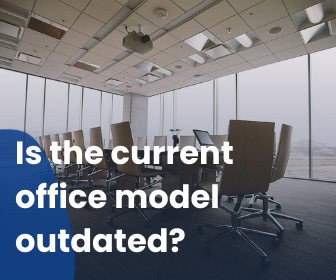
Remember like, a year ago when lots of big businesses were saying they weren’t going to require their employees to go back to the office? And then, inevitability they did. A lot of big companies and whole industries (like, banking and wall street,) have gone back to the office. What did we learn from corporate’s ‘year-at-home’? Are industries and office culture really going to adapt to modern WFH life? Or is the 9-5, 5-day-workweek here to stay?
Advantages of WFH
At the start of the pandemic, many companies feared that working remotely would cut done on productivity. After a year, that has proven not to be the case. Many employees feel more productive working remotely. 82% of senior executives surveyed reported seeing productivity levels either stay the same or increase because of working from home. WFH has cut down on something surprising: innovation.
82% of senior executives surveyed reported seeing productivity levels either stay the same or increase because of working from home.
WFH lowers office costs and shortens commutes. Employees like the freedom. 69% of respondents to Microsoft’s WFH survey said that the main reasons liked working remotely were: dressing more casually, being able to personalize their workspace, and having their pet by their side. Working from home also cuts down on casual workplace interruptions. That same Microsoft study found that before WFH, workers felt like 52% of their workday was wasted due to unnecessary disturbances. That number has fallen to 41% since the beginning of the pandemic.
Michael Parke, a professor at the University of Pennsylvania, who worked on the Microsoft study, said: “It seems that employees are able to hunker down and get less distracted while working remotely… However, the cost seems to be a loss of sense of purpose, which at work, is largely driven through strong and cohesive relationships and seeing how your tasks have impact on others.”

“However, the cost seems to be a loss of sense of purpose, which at work, is largely driven through strong and cohesive relationships and seeing how your tasks have impact on others.”
Michael Parke
Disadvantages of WFH
Working remotely means it’s hard to connect with coworkers, both for formal communication as well as for personal connections. This has had a direct impact on companies’ ability to innovate. The Microsoft study reported that the percentage of leaders who felt that their companies were innovative dropped 16% in 2020. Without sharing a physical space brainstorming and collaboration is more difficult. It’s harder to come up with new ideas as well as enact them.
The overnight and “temporary” switch to working remotely has created many challenges for employers and employees alike. WFH on this scale is such a new thing that solutions to challenges and long-term repercussions are still very much unknown. Being aware of challenges as they come up is the only way for companies to work on effective solutions.
What About A Hybrid Office?
As companies transition back to the office, many bigger companies aren’t seeing it as all or nothing: office vs. WFH. Many companies are trying a hybrid workplace. For example, the London based bank, StandardCharter is pushing and incentivizing a hybrid office model across its global offices. They plan to create smaller office hubs and give employees the choice to work at the office or at home. They are suggesting that employees meet at the office regularly to check in and collaborate. Building We-Work style office spaces will help solve technology deficiencies in their branches in developing countries and will lower costs across the board.
Facebook is also moving to a more hybrid work model. However, they are allowing it more than promoting it. Their current policy is that any full-time employee can request to WFH. Some jobs such as data center maintenance and hardware development will not be allowed to work remotely. They are also planning to adjust salary based on where you decide to work. It is a lot cheaper for the employee to work remotely from a city in the Midwest. (For example, the cost of living in San Francisco, CA is 199.8% higher than it is here in Omaha, NE.) Facebook is going to open all their US offices up to 50% capacity in the fall. Meaning, that almost 30,000 employees will continue to work remotely.
How has the last year of WFH impacted entrepreneurs?
Many people took the opportunity of disrupted work to start new businesses. Many people liked the freedom and flexibility that working from home offered and decided to leave their corporate jobs and pursue entrepreneurship.
“Americans submitted an average of 111,000 applications for new businesses per week between the end of June 2020 and the beginning of September 2020, the most applications submitted per week since 2007.”
U.S. Census Bureau
How do many people feel about going back to the office?
A lot of banks and tech companies went back to the office last week. How do their employees feel about it after working from home for a year and a half? Of the over 1,200 employees and 133 executives surveyed at the end of last year, 55% said they would prefer to still work remotely at least 3 days a week. Along with the loss of flexibility and other perks WFH offers, going back to working surrounded by people can be daunting. A scary as it may be, it will show your employer and teammates your commitment to your job and flexibility in dealing with transitions. Which will be really appreciated! If you are feeling anxious about the return, talk to your boss. Your company may be more open to a hybrid office than you think.
There is never going to be a complete consensus to the question: is WFH better? Every business, every office, and every employee will have a different opinion and method that works best for them. It doesn’t really matter what your company decides to do, as long as it’s the right fit for you.
Do you think a hybrid office is effective?
Your Marketing Needs These 9 Videos
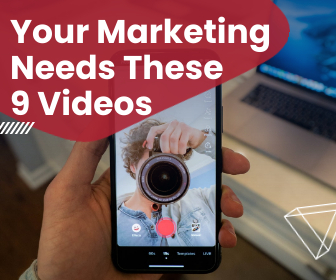
Did you know that are NINE types of videos your business needs? Gone are the days when the only video advertising was television commercials. Now, video is ever-present in our lives. For example, over 2 BILLION users log into YouTube every month. Just like any other tool available, as a business, your brand is going to need different things from different types of videos. Are you using all the kinds of video?
Since different types of videos are used for different things, it’s important to have a well-rounded video strategy. One that helps attract customers, educate them, converts, as well as creates customer engagement and builds relationships. Some types of videos that do that are webinars, promos, digital display, social content, and personalized videos for customers. Some of those are best when heavily scripted and polished, others are great when they feel quickly thrown together. What you need depends on what need you are trying to fill and where the target viewer is on their customer journey. It also depends on how much time, effort, and/or money to pour into video creation.
Explainer Videos
Explainer Video are quick 30-60 videos that explain who you as a company are. It’s basically a pitch video. They great for top of funnel interactions where you need to introduce yourself to potential customers and convince them why they should care about you. They work best when they are made with the audience in mind and feel personal. Don’t forget a strong call-to-action!
You can use Explainer Videos on your website, (think homepage videos) on social media, including YouTube, as well as in ads.
How-To Videos
How-to videos are great for any point of the funnel, can be just about any length, and be used for anything other than ads. However, they don’t need to be extremely high quality or super polished. A real person-to-person feel is more effective. The point of a how-to video is to explain something in a way that will provide valuable content to your audience. This is not the time for a hard sell.
How-to videos are super engaging online because it can feel like pulling back the curtain and letting your audience in on trade secrets!
Promo Videos
Promo videos are basically the general term for commercials. Think short, polished, story driven, exciting videos with strong call-to-actions. They can be used anywhere you need to promote something!
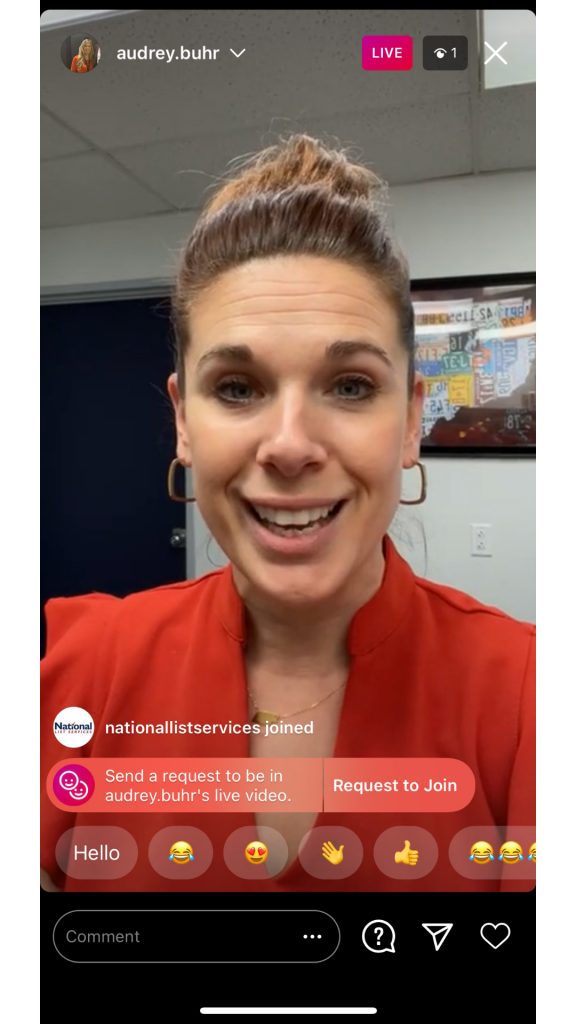
Talking Head Videos
Talking head videos could also be categorized as thought leadership videos. These videos are when you put yourself in front of the camera and share your personality and point of view. These are not designed for a hard sell but instead to show viewers your authentic self and brand personality. Talking head videos work best on social media and on YouTube.
Webinars
I’m going to include podcast videos here as well, (like the video recordings that most podcasts film while recording.) Webinars are inherently educational and therefore the focus needs to be on providing content for your viewers, not selling them. Most webinars are between 15-60 mins. And like in person seminars, they can take many forms: live Q&A’s, lectures, or panels.
Hosting a webinar takes a bit of IT knowledge so it’s totally ok to use a hosting service! It’s a good idea to have a moderator (and maybe an A/V guy) on hand for any troubleshooting or technical difficulties. After the webinar is finished you can make it available for on-demand viewing, as well as cutting the webinar up into smaller clips.
Case Study Video
A case study tells the story of how a real customer uses your product. It provides validation from a third party. Case study video work best when they are clearly planned out and polished. Include the customer/video star on the planning process, that will make the video more authentic. Focus the video more benefits rather than features and back up the information with data.
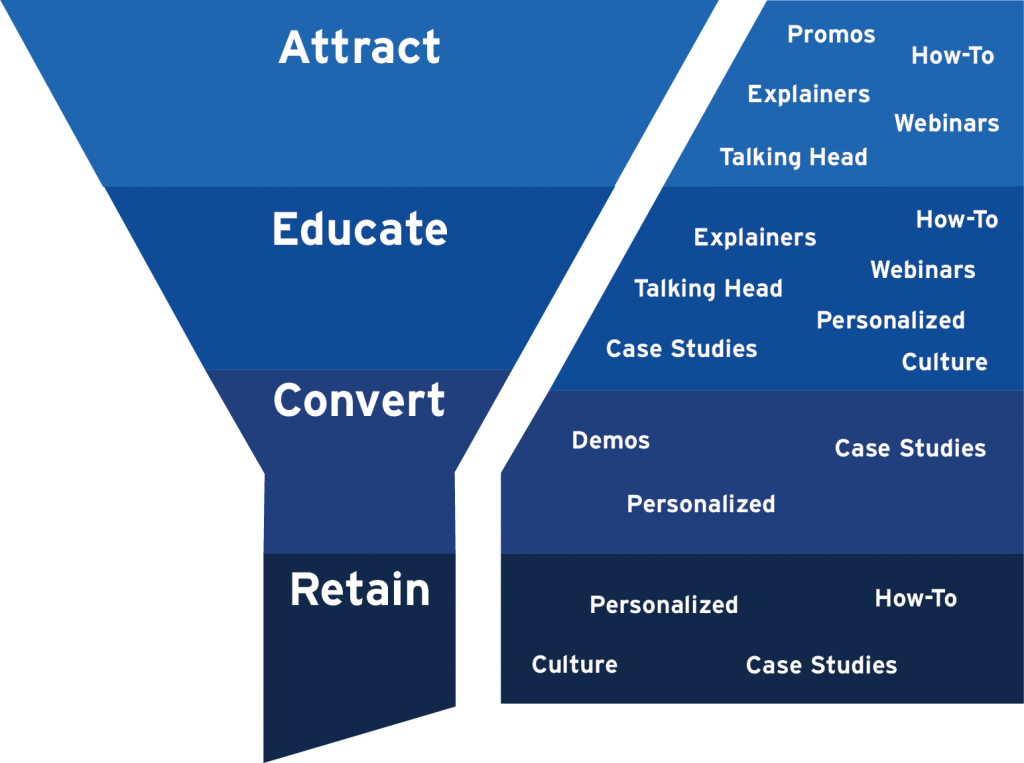
Fun/Culture Videos
These videos are a way to highlight your company’s culture and personality. They help tell your brand story and personality. Often these videos are narrative driven, fun, and humorous. A good example of culture videos is pretty much every company’s TikTok. They are quick and fun and feel personal.
Demo Videos
A demo video is a video that highlights how a product or service actually works. It’s there to educate and inform viewers. Keep the video as concise as possible. They can take a few forms: a broad overview, pre-recorded demo, or live demonstration. For example, we have broad overview demos of National List Services on YouTube, we prerecord demos to onboard clients or answer technical questions, (Loom is great for this) and we often do live demos when showing potential clients how our systems work.
Personalized Videos
Who doesn’t love a personalized video? Sending videos instead of texts or emails to clients is a big part of our follow up. It’s so much more touching to see someone’s face and hear your name than just a written follow up. Because of the nature of our business there are some clients we have never actually met face to face and sending them a personalized video can help bridge that gap.
So, with so many avenues and different types of videos, it’s easy to see why it’s such a popular marketing tool. How do you use video in your marketing?
Need a Refocus Break?
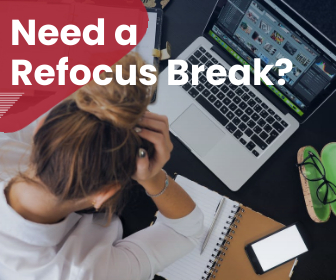
In this digital world, a lot of us probably spend more time at our desks than we’d like to. Long amounts of time staring at a computer can take a toll! Here’s a few things you can do to give you a physical and mental break.
Take a Stretch Break
Admit it, you’re sitting hunched over your keyboard or phone right now. 😜 Its ok; we all do it. Here’s 3 quick stretches you can do at your desk!

#1 Give Your Wrists Some Love
Being on the computer all day overuses some muscles and underuses others. New York City based physical therapist, Dr. Abby Bales, suggests stretching your wrist flexors and extenders. The easiest way to do this is to hold your arm straight out and bend your wrist up and down at 90 degree angles. Bales says this “prevents the wrist from getting locked in a smaller range.”

#2 De-Hunch
Your upper back and shoulders can lock from being at a desk too long. Dr. Bales suggests stretching by clasping your hands behind your head and squeezing your shoulder blades. This opens up your chest and shoulders, helping stop the hunch.
#3 Big Shrugs
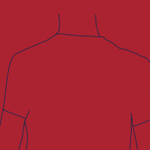
While on the computer most of us have the habit of scrunching up our shoulders and leaning toward the screen. Doing some 3-5 second shoulders shrugs helps! “By actively shrugging and then letting go, the brain is made aware of the unhealthy height of the shoulders,” Dr. Bales said, and it resets accordingly.
Mental Resets
Anytime you disrupt your routine (either by doing little things like pausing to stretch or like, I don’t know, a global pandemic) you have opportunity to reset. What can you do to reset your brain?
#1 Breathe
Pausing and taking a couple deep breathes can help clear your mind, relax, and refocus. It’s as simple as just looking up from your computer or phone and focusing on your breathing for a bit.
#2 Reprioritize
Another thing you can do to mental reset is take a moment to go over your tasks and reprioritize. Ask yourself, “What is my overall goal for the day and what do I need to do next to reach that goal?” It’s critical to understand what tasks are most important. Inevitably things change throughout the day; deadlines move and priorities shift. Reorganizing your task list can help you to stay focused on what really matters and make it easier to adapt to shifting priorities.
#3 Change Up Your Surroundings
Changing something about your surroundings can help you refocus. Can you get up and move? Now that it’s summer, could you work outside? Disrupting your groove gives you the opportunity to reset your focus. Changing where you physically are or even something small like switching up your music is super effective!
What ways have you found to reset your focus and give yourself a physical or mental break?
Scared of Content Creation? Here’s 6 tips

Content creation is an integral part of marketing or running a business in general now. Even if you don’t think that you are a quote-on-quote content creator, you probably do create content. Every time you post on Facebook or update Instagram, that’s content. What are some easy things you can do to up your content game?
Here’s 6 things we have found to be essential in making quality content!
Know Your Audience
The content you create for one audience can be very different from another. Understanding the WHO is helpful first step.
It can also be helpful if you think of your audience as a single composite person. Instead of trying to talk to all of them, you are instead making content for one person. A lot of companies do this by making a buyer persona. That way you can think, “Would my buyer persona like this?” vs. “Would all my followers enjoy this content?”
Make a Plan
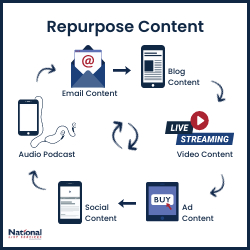
There is nothing more overwhelming than trying to maintain consistent content posting across multiple channels without a plan. It can feel like juggling snakes. 🐍 Making a plan can be as simple as figuring out what types of content you want to post and when it would be best to time to post it. The more specific your plan is the more you time you take out of the equation.
Part of making a plan is planning out your message and/or your angle. Now that you know who your audience is, think about what type of content would work best for them. Knowing what you want to talk about can make it easier to figure out what types of content would be best. Would your audience benefit from long form blog articles or would a TikTok series be more helpful? Both of those types of content take a lot of effort, so planning it out ahead of time is valuable!
Keep It Simple and Honest
Don’t make it harder than it needs to be. No matter who your audience is, needlessly complicated language or content structure isn’t appreciated. Simple and honest is always good. Remember, why you are making the content. Is it to promote you or your brand? Then tone of the content should match your voice. People can see right through any inauthenticity if you are trying to make something that isn’t you.
It’s easier to connect with a brand online if you feel like you are talking to a real person. Does the content you are making sound personal?
What is the Purpose of Your Content?
Why do you want to make this content? Keep the big picture of your content in mind as well as each individual piece. Are you trying to promote a specific product or service? Don’t be afraid to include a call to action in your content! A call to action is how to accomplish the goal of your content. It’s the follow through.
A good call to action is simple and concise. It uses strong verbiage. Give your audience a good reason to take the desired action. Don’t be afraid to get creative!
Take a Step Back
When it comes to content, it’s often valuable to take a step back and from your project and let it rest for a bit. The longer you work on a piece of content the easier it is to be become blind to mistakes, errors, and typos. You may be surprised by the power of fresh eyes!
An old copy writer trick is to proofread backwards. Instead of starting at the beginning of your content: start at the end. Because your brain is following a different path through the information, it sees things in a different way. Starting at the end allows you to look at it sentence by sentence instead of word by word or thought by thought. Knowing your content is edited well will help you feel more confident in posting it.
Another aspect of taking a step back from your content is revisiting old content. Repurposing or adapting finished content is an excellent way to stay inspired and make more content. There are always new things that can be added. Adding information keeps your messages up to date. Up-to-date content is more accurate and provides for value to your followers. Another reason to recycle content is that it gives more people an opportunity to see it. And even if someone has been following you for a long time there’s a good chance that they didn’t see the content the first time around.

Keep Consuming Content
This is my favorite part. 😜 One of the best ways to keep your own content sharp is to consume other content. It can inspire you, help you stay up to date with current trends, and keep your skill sharp. Most ideas don’t start in our heads, the spark is external. All of the creative juices it takes to create content can easily be burnt out if you don’t feed it with creative thing that you care about. Change your scenery, have conversations, read books or articles, watch a movie or show. Diversity of other creative inputs will refill your own creativity!
What’s your favorite type of content to create? How do you stay motivated in content creation?
5 Things To Help You Stay Productive
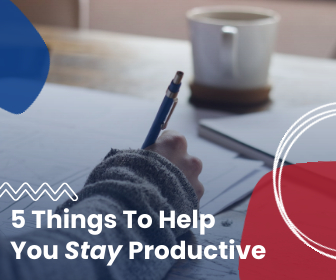
We often focus on tips and tricks to help your business, but nothing is important to your business than you! Did you know that April is Stress Awareness month and May is Mental Health Month? What can you do to make sure you are running at your highest capacity and stay productive?
Managing stress has been a challenge for a lot of people this year. In Asana’s Anatomy of Work 2021 study, 71% of workers said that they felt burnt out at least once in the last year. Also, 42% rated their stress levels as high or very high. When employees are stressed or exhausted, engagement and productivity dip and the whole company can feel the effects.
What Can You Do as A Team to Stay Productive?
Unfortunately, work related stress often has to do with environment. When one person id feeling burnt out on your team, it can bring the whole team down. What can you do to create a less stress inducing work environment?
Talk It Out
Ewww, right? However, it’s impossible to know what is wrong or how you can help a situation if you don’t know at the problem is. Take in interest in people you work with. Is there anything going on in their life that might be adding stress? Is a process or workflow just not working for and its making things difficult?
Once you understand how your team is feeling, don’t disregard it! See what you can do to make things run smoother.
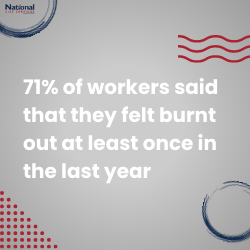
Take Control Over Your Situation
We are all responsible for ourselves. If you are lucky enough to have anatomy in your job, use it! Think about what areas of your job are stressing you and then figure out what you can do to help the situation. For example, do you struggle with being productive in the afternoons because you hit a massive exhaustion wall? Could you be hitting that dip because you constantly don’t get enough sleep? Or does coffee make you crash? Those are things that you have control over and can change.
And after this year, more and more companies are realizing that giving their employees flexibility over schedule and in some cases, whether they want to work from home, actually increases productivity!
Minimize Distractions
The Asana study mentioned early found that “work about work” took up 60% of most employee’s days. That “work about work” is things like, meetings about processes, communicating about specific tasks, switching between tools, waiting for apps to load, searching for information, following up with team members about a project’s status, and managing shifted task priorities. A lot of those things are things that you don’t have control over. However, dealing with tasks like that can quickly give you the feeling of being on a work sized hamster wheel. That’s partly because “work about work” doesn’t feel like you are accomplishing anything.
What can help you feel in control? Figure out the right processes and find the right tools. If you can work with your team to put an effective process in place for dealing with collaborative projects. Part of that involves finding the right tools. There are so many workflow and team management tools available now that it shouldn’t be difficult to find one that works for you and your budget. (We are big fans of Teams/Planner and good old fashioned white boards.)
Time Management
Time management single handedly has the biggest impact on work stressor and burn out. Good time management can drastically increase your productivity and give you more time to focus on other aspects of your life. A healthy work-life balance will help aspects of your life, including reducing stress!
Connect Your Targets to Big Goals
Time management is about getting the work done, it about getting the right things done at the time. A big part of understanding and prioritizing what’s most important is know what your goals. And if you work for a company, what its goals are. A recent study found that only 26% of employees understand how their work relates to the overall company goals. How can you know what daily targets to set if you don’t understand where you are trying to go?
Only 26% of employees understand how their work relates to the overall company goals
This goes back to talk it out. If you have questions, ask! And if you are in a management position, work with your employees so everyone understands what they are doing to help the company reach its goals!
Prioritize and Organize
Its critical to understand what tasks are most important. Inevitably things change throughout the day; deadlines move and priorities shift. If you understand what’s most important in the grand scheme, however, it can make adapting to those changes easier. In the Asana study, they found that 29% of employees cited confusion on task priorities as a contributing factor to their burnout.

There are many different methods to prioritizing and organizing your daily tasks. The “Eat The Frog” method (named after the famous Mark Twain quote) encourages you to take care of the big or complex tasks first thing in the morning. This way you are productive right out the gate and don’t have a big task hanging over your head all day. Once you’ve eaten the frog you can move to other things.
Another popular method is David Allen’s “Getting Things Done” method. The first step in this method is write everything you need to get done down. Once you have an overview it’s easy to see what tasks are important. Writing it all down and putting it one place frees up brain power and lets you focus on actually getting the stuff done.
Plan Ahead
Writing down your targets for the next day before you finish for the night or as you think of it, helps you feel on top of the day as soon as it starts. Spending a few minutes to plan out tomorrow’s tasks is way easier than spending the first part of your day scrambling to remember what was a priority to get done that day. This will also help your work life balance because you don’t have to keep thinking about all you have tomorrow.
Say “No” or Delegate
This is a struggle, we know. But one advantage of having clear, prioritized tasks, is that you can see when a task is not a priority or not one you have time for. It’s easier to explain why you are saying no if everyone knows what your current priorities are. Sharing your clearly defined priorities with your team gives everyone more clearly. This is something that we have found to be successful. In our morning meeting we often go through what everyone’s priority tasks for the day are. By doing this, we know what each of us needs to be focusing on and how much a priority it is to reach our company goals. It also makes it easier to see where we could help.
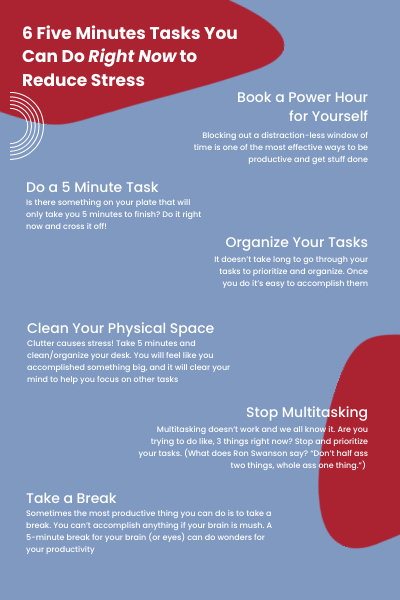
Knowing what your team’s priorities are, can also make it easier to delegate tasks. Just because something is a priority task for you doesn’t mean it’s not important! Help it get to the right person and that benefits everyone.
Audit Your Tasks
Is there anything on your plate right now that doesn’t align with your goals? Ask yourself, is this task not a priority for today anymore? Or is it not a priority at all? If the task is still important but keeps getting moved to the bottom of your priorities, ask yourself if you are the right person to be handling it?
Another aspect of auditing task is looking at how you view the task. Are you procrastinating the task because you don’t really want to do it? It’s easy to add time to situations if want to avoid the task. However, tasks don’t usually take care of themselves. (wouldn’t that be nice?) procrastinating the task will just make it worse. And often, when we finally do something, we’ve been procrastinating, we find it wasn’t that difficult in the first place!
What have you found successful in dealing with work stress? Any time management tricks you swear by?
The Apple Update and Data Privacy
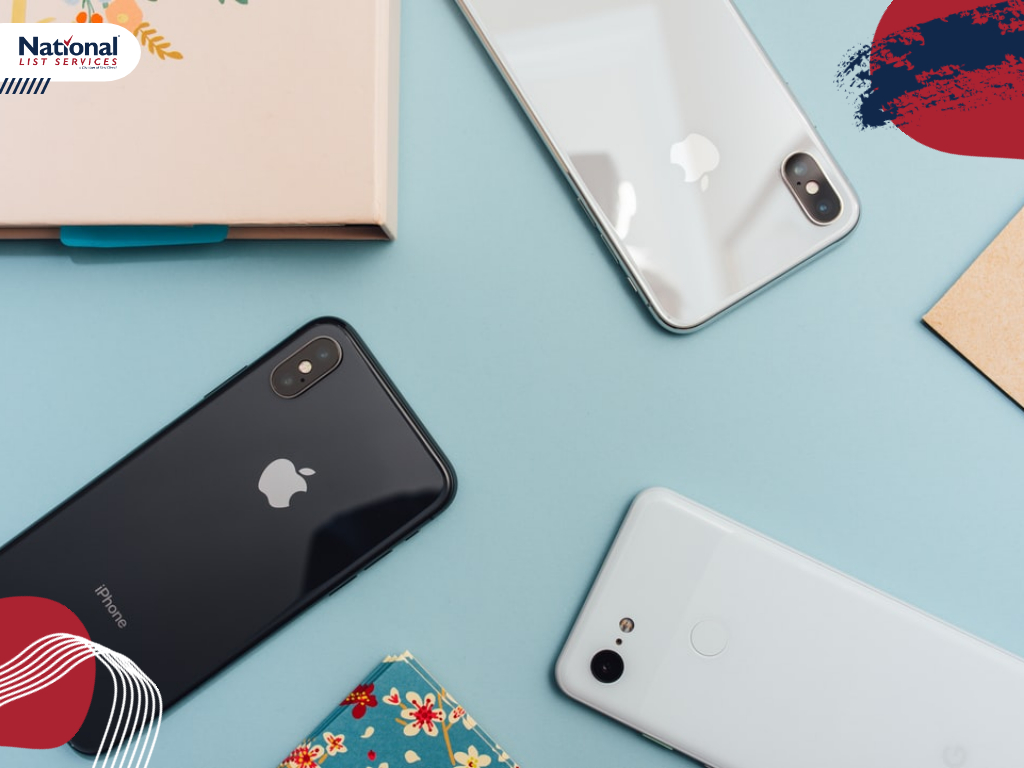
Apple is rolling out an update this week that finally does what they’ve been threatening to do for a lonnnggggg time. Control over the ADFA (Apple’s Device Identifier for Advertisers) and other app tracking tools designed for marketing are being given directly to the users. What Apple decides to do when it comes to privacy and marketing tools greatly impacts the entire industry. Why? For one thing, 45.2% of smartphones users in the United States have an iPhone. Another reason is that they have marketed themselves as the company that is going to stand up for its user’s privacy and control, even if that means going against Facebook. Or the Government.
The big question is though… what does it mean for you? As a user and as an advertiser?
What are they actually doing?
With the new update scheduled to go out this week, Apple is introducing a feature called “App Tracking Transparency.” What does it do? Well… it makes advertiser tracking between apps more transparent to users. Apple has made the ability to see (and change) what apps are tracking what for years, the difference now is that instead it being buried deep in settings, a pop-up window will show up on every app that tracks something or collects any data. This pop up (like the one for sharing location) will allow users to control what personal data each app has access to as well what other apps it can connect to.
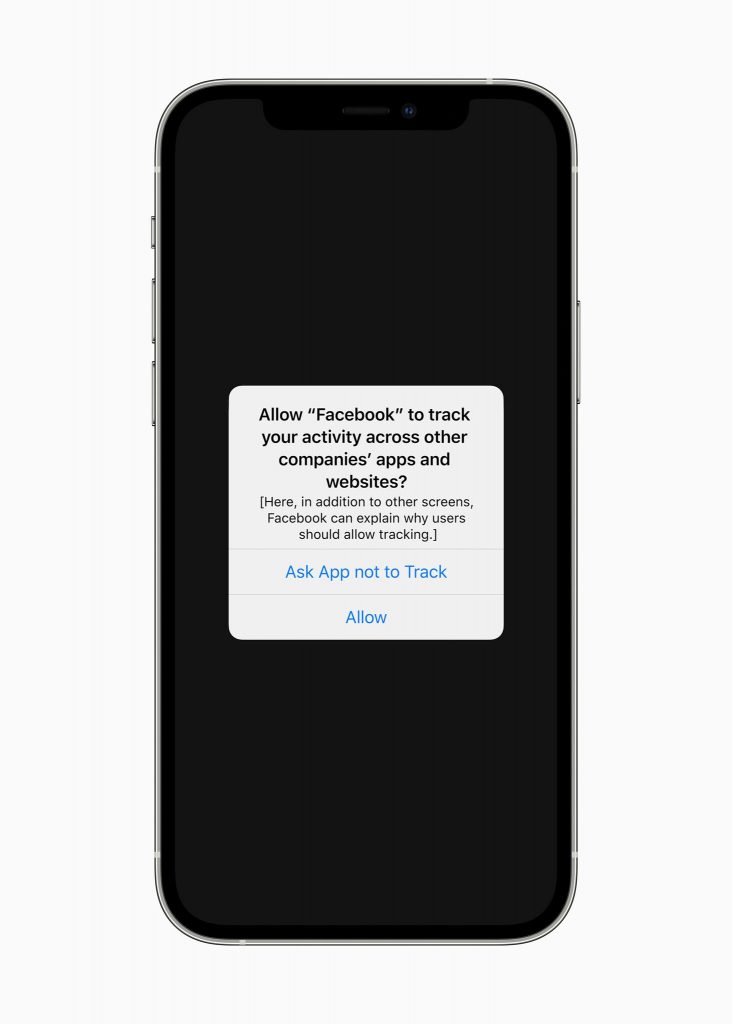
What information are apps collecting/what are they collecting? Apps (and websites) can collect a surprising amount of information that users haven’t directly given them. Some apps track your physical location. They can use this information to serve you targeted ads based on where you are in the physical world. Knowing your physical location can also give you better recommendations on things “near you,” whether that be pizza for lunch or the weather forecast.
Apps also can have tracking pixels built in. These pixels can track your movement form one app or website to another. This is how you can get an ad for something you just looked at on Amazon. Amazon has a tracking pixel built into their website, they in turn take the information the pixel has collected about visitors to target them on other websites and apps.
What choice do users have now?
In the popup window, users will now be given the choice: “Allow” and “Ask app not to track.” In the past Apple has let you decide which specific elements you would allow, like only location sharing or only ADFA tracking. However, this feature appears to be all or nothing. If you “Allow” then you are giving complete access.
What happens when you say no to tracking? Apple stops giving the app access to your ADFA, stopping it from learning about you from other apps. It also tells apps that you really would rather they didn’t track or share your information in any other ways.
Why should you allow tracking?
Personalized ads are one part of the puzzle when it comes to be tracked online. As we’ve talked about in the past, personalized ads are very effective. Younger generation that have grown up online don’t tolerate non-personalized ads very well. We are constantly inundated with content and advertising, so it is easy to completely zone out advertising (in any form) that is something you are not directly interested in. Also, many consumers now have in innate understanding of how their personal data is used to create targeted ads. Being targeted (or retargeted) based on their interests and past activities are expected. Recently surveyed consumers between the ages of 18-34, 58% said that a personalized ad helped them make a purchase decision. 42% also said that they had clicked on a sponsored ad in the last 6 months!
For a lot of us, the privacy concerns pale in comparison to function and usability of an app. A TapResearch poll conducted in August 2020 shows that 23% of iOS users are likely to opt in to sharing data with apps that request it. Another 21% of consumers are neutral on the subject, suggesting they will not opt out. Recent eMarketer research shows that 75% of consumers are willing to share their location if it enables a mobile service or saves them money. Which highlights how many users feel about personalized advertising: getting a coupon or an ad for something you were probably going to buy anyway is not a bad thing.
The Facebook Controversy
Facebook has been by far the most outspoken opponent of AppTrackingTransparency, going so far as to take-out full-page ads in newspapers and other print publications. Facebook says that AppTrackingTransparency will hurt small businesses’ ability to advertise to those in their community and Apple shouldn’t be able to make “unilateral decisions without consulting the industry about a policy that will have far-reaching harm on businesses of all sizes.”
Apple shouldn’t make “unilateral decisions without consulting the industry about a policy that will have far-reaching harm on businesses of all sizes.”
Facebook
In general, the consensus seems to be that Facebook is upset because of their ongoing rivalry with Apple and more importantly, this decision’s impact on their own revenue. In the months since its announcement Facebook has changed its tune a bit. Zuckerberg said in an interview in March on Clubhouse that Apple’s new privacy policy may actually help Facebook; if advertisers can’t find space across iOS apps they may turn to Facebook.
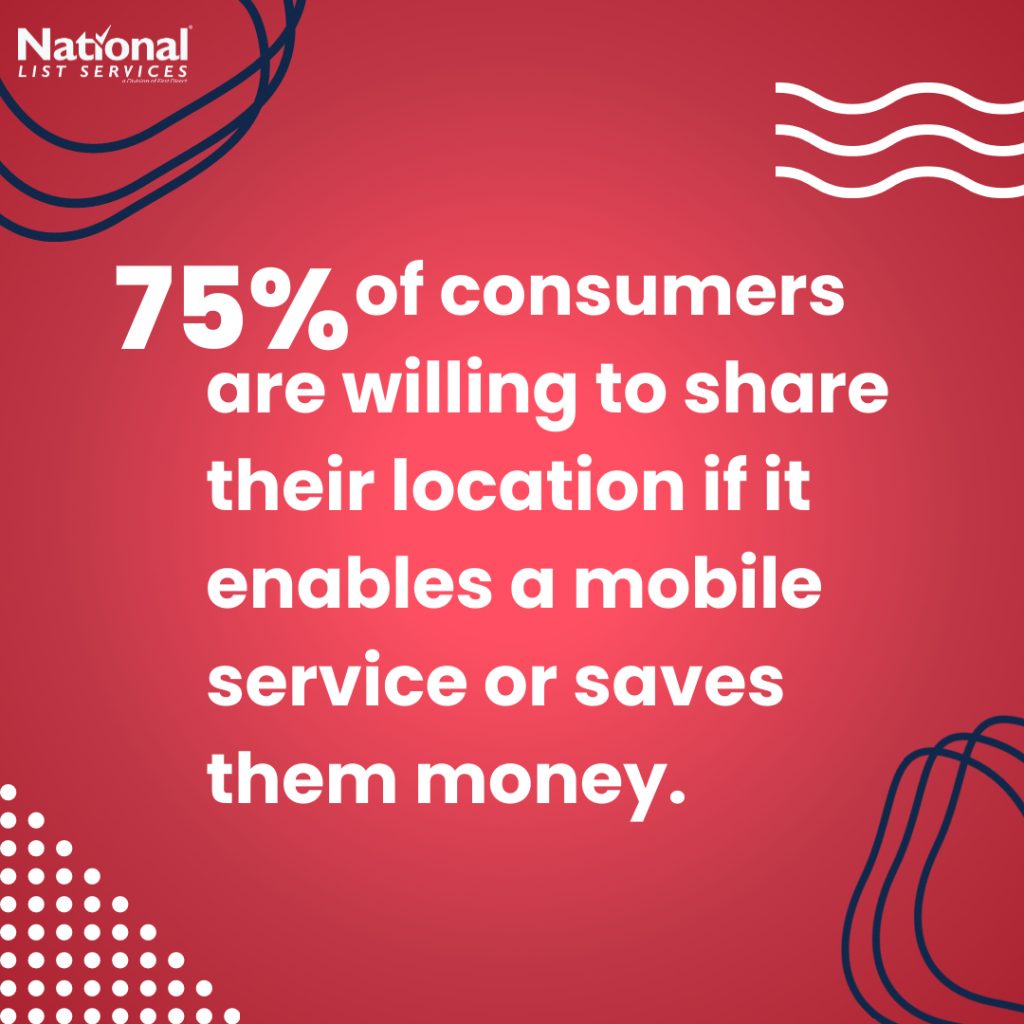
Time will tell if these changes pull advertisers more into Facebook marketing, but one thing is for sure, they have already impacted Facebooks. We were sent this by Facebook this week: “Apple released changes with iOS 14 that impacts how we receive and process events from tools like the Facebook SDK and the Facebook pixel. See updates on how these changes affect your ad account and see tasks that can help you reach your audience.” So far, the only thing we’ve seen impacted on Facebook is size audiences available. That is expected to level out though, in coming months as people re-opt-in to app tracking.
What are advertisers doing about it?
Many apps already have another type of pixel technology built into them called “Fingerprinting.” Fingerprinting has been developed recently to combat this end of cookie era. Fingerprinting works by collecting seemingly unimportant data from your device such as screen resolution, phone model, and current operating system, and combining it into a way of recognizing your unique device. Much like actual finger printing, fingerprints match to fingerprint, not a name, address, phone number etc. This allows advertisers to target you with ads without knowing who you actually are, thus getting around any data privacy issues.
There are many tools becoming available that do similar things. Tools like Household Level Identifiers that don’t target specific people. Apple hasgiven advertisers time to come up with solutions, many of which probably haven’t been released yet!
So, what do you think? Do the advantages of AppTracking outweigh the privacy costs? Are you going to allow AppTracking?
